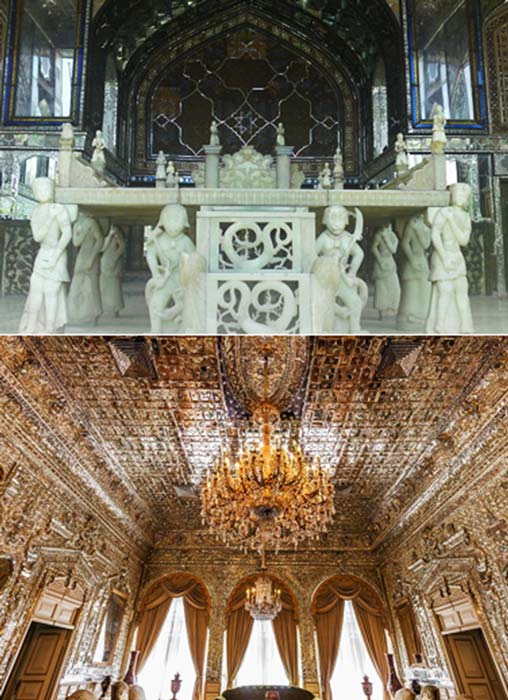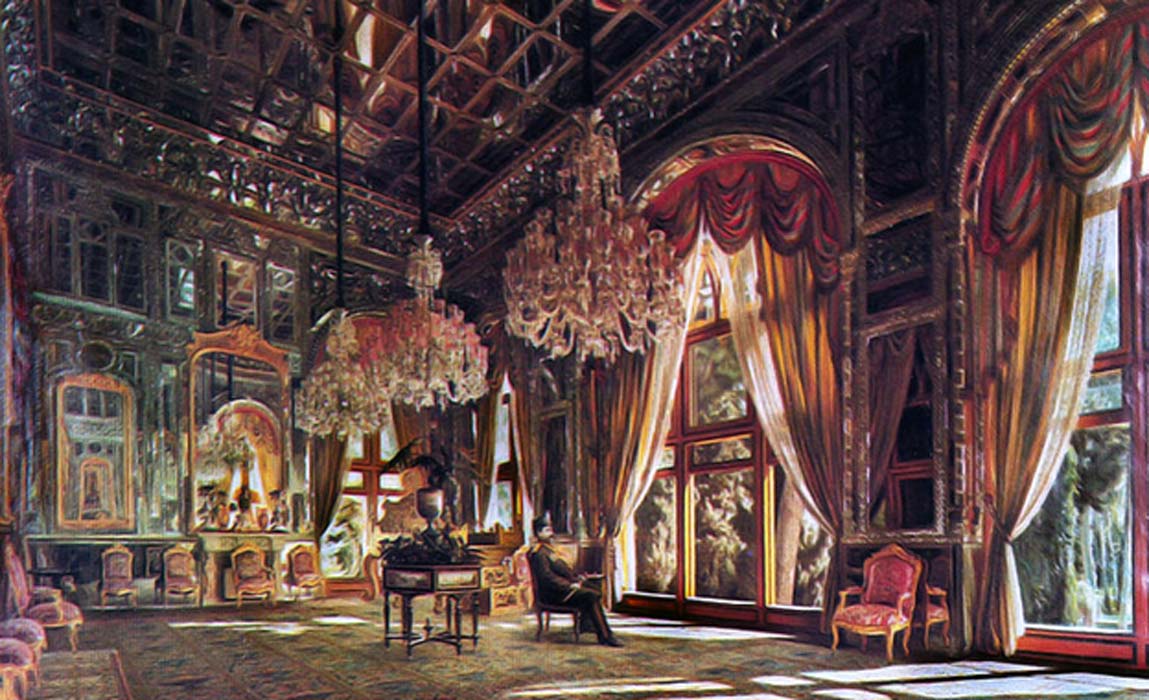What Wondrous Sights Have Been Seen in the Brilliant Hall of Mirrors at Lavish Golestan Palace?
Golestan Palace (which means the ‘Roseland Palace’ in Persian) is a palace complex that once was part of a group of monuments situated within the mud-thatched walls of Tehran’s Arg (citadel). The Golestan Palace consists of a number of magnificent buildings with well-kept gardens. Whilst the Arg and the Golestan Palace were developed as early as the 16th century by the rulers of the Safavid Dynasty, it was during the Qajar era in the 18th century that the palace received the form that visitors see today.

Elaborate decoration in Golestan Palace, Tehran, Iran. (Diego Delso/CC BY SA)
Oldest Surviving Structures at Golestan Palace
Golestan Palace is located right in the center of the city of Tehran, the capital of Iran. It was during the middle of the 16th century that Tehran began its rise in importance. During this time, the city was chosen to be one of the residences of the Safavid rulers. As a consequence of this, a defensive wall was built in the 1550s, during the reign of Shah Tahmasb. The foundation of the Golestan Palace was also laid, in the form of a small palace and an audience chamber, which no longer exists today.

"Golestan palace springhouse" (1889) painting by Kamal-ol-molk. (Public Domain)
The earliest surviving structures of the palace complex date to the Zand Dynasty, one of the successors of the Safavids that was in power during the second half of the 18th century. Karim Khan-i Zand, the founder of the Zand Dynasty, intended to make Tehran his capital. Therefore, in 1760, he had the architect Ustad Ghulam Reza commissioned to renovate the defensive wall, and to build additional structures in the complex. One of these was an audience chamber known as the Divan Khana, which was later transformed into the Imarat-i Takht-i Marmar. Another is the Khalvat-i Karim Khani.
- The 4,000-Year-Old Abandoned Mud-Brick Town of Kharanaq, Iran: A Photographic Look
- Arg-é Bam: An Ancient Citadel Destroyed By Nature and Reconstructed By Humanity
- Queen of Sweden Says Her Old Palatial Home is Haunted by Friendly Ghosts

Panorama of Khalvat karim khani, Golestan Palace, Tehran, Iran. (Nasser-sadeghi/CC BY SA 3.0)
Fusing Persian and European Architecture
It was, however, during the Qajar Dynasty that the palace complex received its most distinct features. In 1789, the Qajar Dynasty was founded by Agha Mohammad Khan Qajar, and Tehran was chosen to be the dynasty’s new capital in 1785. Golestan Palace was selected as the king’s residence and administration center. Whilst the new ruler had many construction plans in mind, most of them did not come to fruition as he was assassinated in 1797.

Mohammad Khan Qajar, the founder of the Qajar dynasty of Iran (Public Domain), Fath Ali Shah (Public Domain), and Naser al-Din Shah by Abul Hasan. (Public Domain)
It was Agha Mohammad Khan Qajar’s successor, Fath Ali Shah, who was the first ruler to have substantially developed the Golestan Palace. Apart from initiating his own building projects, he also completed some of his predecessor’s. The development of Golestan Palace continued under the fourth ruler of the Qajar Dynasty, Naser al-Din Shah Qajar, who was the great grandson of Fath Ali Shah. Many modifications were made to the Golestan Palace during the ruler’s 50-year reign.
- Scholars rethink the beginnings of civilizations following discoveries in Burnt City of Iran
- The Ancient Site of Takht-e Soleyman: Iran’s Throne of King Solomon
- Topkapi – A Palace of Dreams and Tears from the Ottoman Empire

Marble throne at Golestan palace in 1840. (Public Domain)
The most distinct feature of the Golestan Palace is the co-existence of Persian and European architectural elements. Naser al-Din Shah Qajar is known to have been the first modern Iranian ruler to have formally visited Europe. It was during these trips (the first in 1873, the second in 1878, and the third in 1889) that the Persian monarch was exposed to European Neo-Classicism, which influenced many of the buildings that were to be built in the Golestan Palace. One of these, for example, was the Kakh-i Ab'yaz, which was added in 1891, and was the final building in the complex. Whilst this structure adheres completely to the architecture of the European Neo-Classical movement, other buildings, such as the Shams al-Imarat, the tallest structure in the complex, display a fusion of Persian and European elements.
The Marble Throne Room and Hall of Ivory
During the subsequent Pahlavi period, Golestan Palace underwent more changes. During the reign of Mohammad Reza Shah, for example, about three quarters of the structure was demolished so that more space could be made for modern office buildings. Nevertheless, many of the impressive buildings, including the Imarat-i Takht-i Marmar (the ‘Marble Throne Room’), where formal receptions were held, and the Talar-i Aaj (the ‘Hall of Ivory’), where gifts from foreign countries were kept, have been preserved.
Today, Golestan Palace is a World Heritage Site, and is open to visitors.

The Marble Throne (CC BY SA 3.0) and Talar e Brelian (Brilliant Hall). (Diego Delso/CC BY SA)
Top image: A painting of the Talar-i Aineh (the ‘Mirror Hall’) in the Golestan Palace by Kamal-ol-molk. Source: Public Domain
By Wu Mingren
References
Golestan Palace, 2017. A short history of the Golestan Palace. [Online]
Available at: http://www.golestanpalace.ir/en/history.html
Lonely Planet, 2017. Golestan Palace. [Online]
Available at: https://www.lonelyplanet.com/iran/tehran/attractions/golestan-palace/a/poi-sig/1448638/361025
Mirrazavi, F., 2016. Golestan Palace. [Online]
Available at: http://www.iranreview.org/content/Documents/Golestan_Palace_2.htm
Pazira Travel Company, 2017. Tehran Golestan Palace Museums. [Online]
Available at: https://www.uppersia.com/Iran-museums-and-galleries/tehran-golestan-palace-museums.html
UNESCO, 2017. Golestan Palace. [Online]
Available at: http://whc.unesco.org/en/list/1422



















